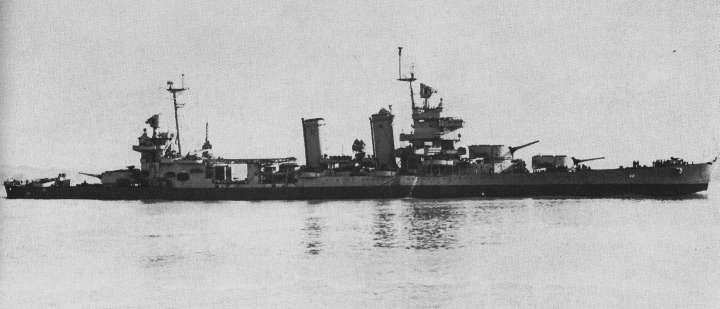

The design of the New Orleans class, the last major class of heavy treaty cruisers in the U.S. turned out to be the most balanced of them with the possible exception of Wichita. It corrected the most pressing problem with earlier constructions, their overly great difference in tonnage from the 10.000 ton limit – always about 1000 ton below.
After the Bureau of Construction and Repair had to ist sorrow found out that ist previous designs had come out woefully light, it was prepared to go for increased protection on new-construction vessels. Thus when in 1928, the construction of cruisers CA 32 – 36 was granted, the most immediate demand, as made by the General Board was “any weight which might be found available be used in the increase of protection, primarily of the magazines”.
Significant additional plating could be provided there both to protect the magazine and the ammo lifts, and to mount a plotting room within the armored part near the magazines. At the same time, armor protection everywhere else, over and around machinery, guns, important control stations all remained weak and capable at most of stopping five inch destroyer shells – gun houses and command and control facilities being hard-pressed to even handle those.
Another problematical situation was due to the position of the magazine above the waterline, where, though adequately protected against underwater weapons – torpedoes, mines, near misses by bombs --, it would be vulnerable to the fire of surface vessels, especially that of the most likely opponent of theirs, the enemy’s cruisers.
Alas, any change in the design, now, would entail modifications that, at the same time, would be costly and time consuming, since the dispersion among Navy and private yards brought along contractual obligations for two of the vessels.
Those ships, Indianapolis and Portland, would later on the excluded from the construction of the New Orleans class and be build to the exact original specifications as seen above. The other three, CA-32, -34 and –36, would receive modifications equal to those C&R now proposed for the follow-on batch, CA-37 through –41.
In those ships, a radical redesign allowed for the magazines to be placed below the waterline, which necessitated a reduction in weight (for the lower placement required extra armor and bulkheads), which was achieved by giving up on the compartmentalization of machinery spaces as exercised in the Northampton class, and by gambling on the availability of a more efficient boiler that would allow a shortening of the machinery spaces by four feet per boiler.
Further additions were made to the design, including armored gun turrets as opposed to the mere mounts covering by steel in the previous classes. Six inch front plates and 2.25 inch tops and 1.5 inch sides sitting on 5 inch barbettes, as well as an armored conning tower, made these ships the finest treaty cruisers that kept within the limits imposed.
The previously scheduled torpedo tubes were subsequently removed and the foremast altered to mimic that of the rebuilt New Mexico, but the major design work had been done and in April 1930, the Bureau of Construction and Repair’s design was applied to the cruisers New Orleans, Astoria and Minneapolis, already in the works, accepting a 12-month delay and additional costs to build them into full-grown New Orleans-class ships instead of the inferior Indianapolis standards.
The succeeding four ships, which were added piecemeal and did not adhere to the succession that had been established in previous plans, all were altered to one extend or another, but all kept the general design features of the New Orleans as build, except that barbette armor was altered to 6.5 inch in San Francisco and Tuscaloosa, and back to 5.5 inch in Quincy and Vincennes.
Ships in class:
New
Orleans, CA-32
Astoria,
CA-34
Minneapolis,
CA-36
Tuscaloosa,
CA-37
San
Francisco, CA-38
Quincy,
CA-39
Vincennes,
CA-44
|
|
Displacements:
Standard: 10.047 tons Full: 11.515 tons Length: 179.22m / 588ft Beam: 18.7m / 61ft 9" Draft (Full Load): 6.6m / 21ft 7" Height: 35.4m / 116.1ft Crew (Officers/Men): ??/????, Total 868 Endurance: 10.000nm at 15 knots Speed: 32.7 knots |
|
|
Belt: 143 (Magazines)
- 65mm (Engine & Boiler) / 5.75 - 2.6"
Deck: 57mm / 2.2" Barbettes: CA-32/-34/-36: 127mm / 5" CA-37/-38: 163mm / 6.5" CA-39/-44: 138mm / 5.5" Gunhouses (Front/Top/Sides): 152mm/56mm/38mm / 6"/2.25"/1.5" Conning Tower: 127mm / 5" |
|
|
(As designed):
Main: 9 x 203mm L/55 in three triple turrets, two superfiring forward, one aft Secondary: 8 x 127mm L/25 in four single mounts, four on each side AA: 8 x 12.7mm in single mounts Torpedos: None Aviation: 4 planes, two catapults |
| (New Orleans,
1942):
Main: 9 x 203mm L/55 as above Secondary: 8 x 127mm L/25 as above AA: 16 x 28mm in four quad mounts 12 x 20mm in single mounts Torpedos: None Aviation: 4 planes, two catapults |
|
| (San Francisco,
1944):
Main: 9 x 203mm L/55 as above Secondary: 8 x 127mm L/25 as above AA: 24 x 40mm in quad mounts 26 x 20mm in single mounts Torpedos: None Aviation: 4 planes, two catapults |